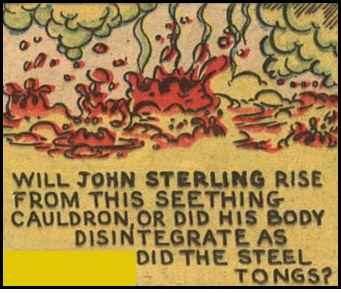
One month after The Shield premiered in PEP Comics #1, MLJ (now Archie) Comics releases ZIP Comics #1 (February, 1940), featuring John Sterling, The Man of Steel. Even though Steel appeared almost two years AFTER Superman, he is actually the very first Man of Steel. Supermanís original sobriquet was The Man of Tomorrow, and he would not adopt Steel's until after ZIP ceased publication in mid-1944.
Steel Sterling's origin is quite similar to The Shields. Both heroes' powers are artificially induced in a laboratory, and both tragically lose their fathers in a way calculated to provide motivation. The difference is that while The Shields old man was killed through the actions of German spies, Steel's is murdered by the minions of organized crime. Subsequently, The Shield would battle Hitler stand-ins for almost two years before war was actually declared, while Steel Sterling would stick strictly to fighting hoodlums and racketeers.

Artist and co-creator of Steel, Charles Biro, almost certainly influenced the emphasis on crime, considering that he would be credited (later) with the creation of the Crime comic craze. Biro, another alumnae of the Harry "A" Chesler Shop, was a most prolific creator/artist. Steel Sterling is an example of very early Biro, before he had fully developed the over-the-top style that 1950's cultural moralizers would find so offensive. The interior art, as well as the covers, were handled by Biro for the first 15 issues of ZIP.

"If Jack Kirby was the most important artistic force in comics during the 1940s, Biro certainly proved to be the finest editor and writer. While others were providing escapist fantasy in their comic books, Charles Biro decided his books would be different and better. He even dubbed them 'Illustories,' but the name never caught on. Throughout his 16-year stint as editorial director and chief writer at Lev Gleason, Biro proved to be the most innovative and certainly most advanced writer in the comic book field." -Joe Brancatelli.
Co-creator Abner Sundell, the writer and co-creator of the series, was known as a writerís writer. His style influenced the early creators, and his theories on writing comics were published in the Writers Guide of 1942 under the title: 'HOW TO CRASH THE COMICS! "Sell to this fertile field of over 100 markets!" (http://theages.superman.nu/Creators/sundell.php)

Joe Blair, an MLJ regular, took over the scripting by issue #16, but unless Blair was an artist too (and I'm not sure that he was), the art credit is absent for a handful of installments.

Starting with ZIP #18 (September, 1941), comic great Irv Novick takes over the art chores on Steel (with a cover illustration uncharacteristic of Novick that was probably either laid-out or influenced by Biro, above), putting in place a creative team that would craft some of the best Steel stories ever told, starting with the first post-Pearl Harbor tale in ZIP #26, and followed the next month (#27) with the first appearance of the dread Baron Gestapo. Links to both of these above-average stories can be found after the short origin story of Steel from ZIP Comics #1, below.
Sources:
http://theages.superman.nu/Creators/sundell.php
http://www.internationalhero.co.uk/s/stelster.htm
http://www.crimeboss.com/history02-1.html
http://www.sugarbombs.com/kavalier/?page_id=13
http://www.internationalhero.co.uk/s/stelster.htm
http://www.crimeboss.com/history02-1.html
http://www.sugarbombs.com/kavalier/?page_id=13


































